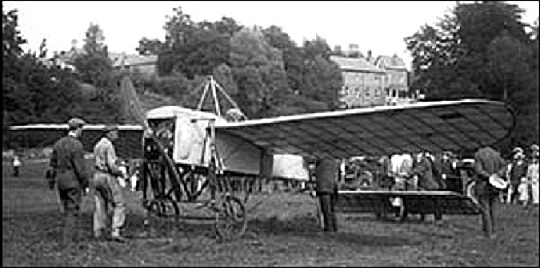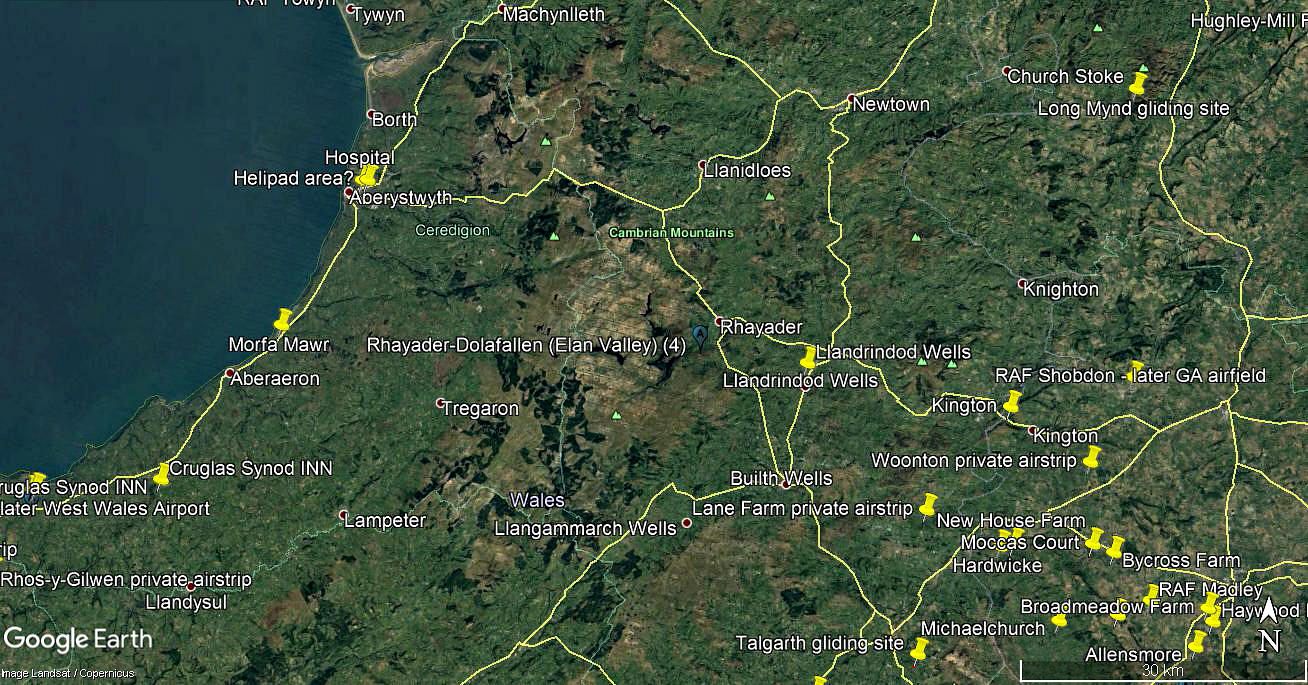Llandrindod Wells
LLANDRINDOD WELLS
Note: These pictures were obtained from Google Earth © and the maps and pictures were kindly provided by Mr Michael T Holder
NOTES: I have to thank Mr Graham Frost, a great friend of this 'Guide' to drawing my attention to aviation in this town which was being ommited from the 'Guide'. I clearly needed to delve a bit deeper, and the initial results were, to say the least - quite surprising. I then enlisted the help of Mike Holder and also did some extra research myself. Hopefully the end result will be really quite interesting.
THE FIRST ARRIVAL
This was Gustav Hamel who flew from the racecourse on the 29th August 1913. The first pilot to make an exhibition of flying in this area.
Mike Holder, bless him, unearthed an astonishing amount of information, which included this account from the Western Mail published on the 6th August 1914:
COOL WELSH AVIATOR
_________♦___________
MR. VIVIAN HEWITT MEETS WITH A MISHAP
__________
"An unfortunate accident befell Mr. Vivian Hewitt, the well-known Rhyl aviator, at Llandrindod Wells on Wednesday afternoon. Mr. Hewitt was to have given a flying exhibition, and a large crowd had assembled. When about to fly Mr. Hewitt attempted to lift his monoplane over some trees. Unfortunatley, his engine failed, and he crashed into the trees. His machine was badly damaged, but Mr. Hewitt escaped injury. He calmly crawled out of the wreckage and lit a cigarette."
From this point it appears that nothing happened here until the 31st May 1932 when Sir Alan Cobham's National Aviation Day Display Tour arrived. The following year, on the 22nd May 1933, the British Hospitals Air Pageant arrived to give a display, and the fifth picture above is from that display. The clue being the DH84 Dragon in the picture, which without much doubt was G-ACCR registered to R T Boyd and W Rollason, William Rollason being the pilot. Most of the 'Flying Circus' operators, including the biggest and best such as Sir Alan Cobham's Tours, hired in supporting 'sub-contractors'.
In those days having a DH84 Dragon available for carrying passengers on joy-rides would have been a major attraction. Its first flight was in November 1932 and the incipient regional airlines were queuing up for one. So to have this example on the 'Flying Circus' circuit would have been quite a coup.
ANOTHER MAJOR DEVELOPMENT?
Mike Holder found this extraordinary advert:
DAILY FLYING
At LLANDRINDOD WELLS
Commencing FRIDAY, August 3rd (until further notice)
"There are now many provincial aerodromes in existence but not until this year has it been possible to establish regular flying in the heart of the of the Principality, although the Premier Welsh Spa has been gradually forging ahead in developing this exhilarating and modern form of travel."
"Llandrindod Wells now possesses a centrally situated compact aerodrome (adjoining the Rock Hotel) with twenty-five acres and 550 yards long complete with hangarage to house a number of machines. Owners of private aeroplanes are therefore able to fly to Central Wales and even make their base for daily tours over country so famous for its beauty. The landing fee is 2/6 per machine and the cost of hangar space per twenty-four hours 5/-. Fuel and oil supplies available on landing ground."
What we need to remember of course is that the average weekly wage for a skilled worker in this area of the UK, was probably around £1 a week. For younger readers there were twenty shillings in a pound, and twelve pence in a shilling.
"Commencing on Friday 3rd, Messrs. Universal Aircraft Services Limited will experiment with a daily service and are prepared to make short or extended air tours at reasonable charges in addition to providing rides over the immediate neighbourhood at very popular prices. For this purpose the following machines will be placed in commission."
"An 'Avro' 504K biplane seating pilot and two passengers and a 'Bristol' biplane with 275 h.p. Rolls Royce Falcon engine, seating pilot and one passenger."
Sounds really great does it not? The sad reality was that this was a very chancy enterprise at best. They had worked out a scale of fares to include destinations such as Bristol, Birmingham, Cardiff and even London. Comparing hire car charges and mileages. (A hire car in those days being a bespoke chauffeur service - and not self-drive).
It appears that Universal Aircraft Services, also based at WITNEY (OXFORDSHIRE) had just two aircraft, both WW1 types. The Avro 504K was G-ABWK, (ex E9353) and first registered in June 1932. Apparently registered to Universal in April 1933 and sold on in August 1934. In those days the Avro 504 was the backbone of 'Flying Circus' and 'Joy-riding' operators. Avro could quickly and relatively cheaply convert the rear cockpit to take two passengers.
The 'Bristol' biplane is especially interesting as this was a Bristol F.2B Fighter G-ACCG. Apparently registered to Universal Aircraft Services in February 1933 it was sold on in October the same year. One really does have to wonder why on earth such a type would have been considered practical, especially as it had not been modified to carry two passengers? Being basically a WW1 fighter-bomber design, with a gas-guzzling engine, what could have been the 'Business model'? Probably we shall never know.
Incidentally, although we in the UK generally consider the 'Brisfit' to have been obsolete not so long after WW1 ended, it appears that limited production continued until 1927. The reason being that the RAF found the type to be very suitable for operations in the Middle East and beyond. Indeed it appears that the type was finally withdrawn from RAF service in India during 1932.
Still, be that as it may, the problem remains why Universal saw air taxi potential, over quite considerable distances, in outdated open-cockpit WW1 designs when so many other operators were flying cabin types. Which of course enabled passengers to fly in casual clothing rather than being bundled up in a warm weatherproof coat, helmet and goggles.
Taking the most extreme example of destinations, London, the price for an air taxi flight was in the Avro with two passengers was £13 16s, the 'Bristol' with one passenger was £17 5s. Quite probably a lack of funding forced the issue? Very much a severe problem, even today when banks etc still so often totally fail to understand the very basic principles of cost-effectiveness. And they are not alone!
A WEE BIT OF EXPLANATION
For example the DH83 Fox Moth first flew in March 1932, and could carry four passengers. I can't find out what the range would have been - generally speaking payload needs to be traded off against the fuel load, even in much more modern aircraft. When 'Ted' Hillman, the coach operator started his airline from MAYLANDS (ESSEX) with a service to Clacton in April 1932 it was equipped with two DH80A Puss Moths, which could carry two passengers. The Puss Moth could fly at 124mph whereas the 'Bristol' had a top speed of 123mph and would have consumed, at a rough guess, at least twice as much fuel.
So, without putting too fine a point on it, the enterprise was doomed from the start.
We'd love to hear from you, so please scroll down to leave a comment!
Leave a comment ...
Copyright (c) UK Airfield Guide






















